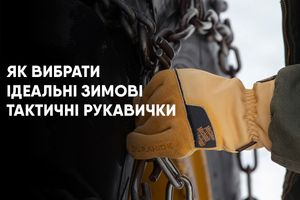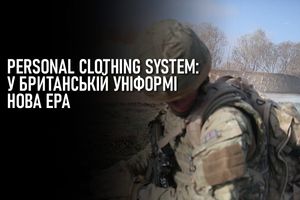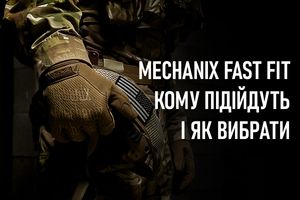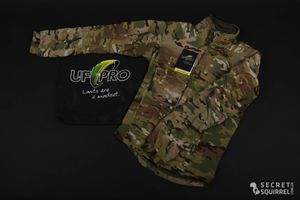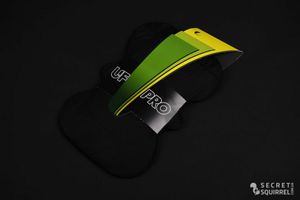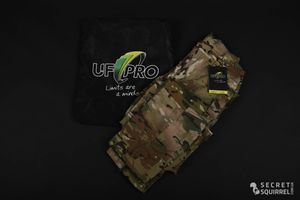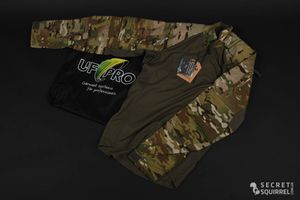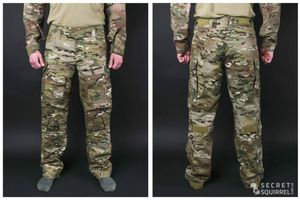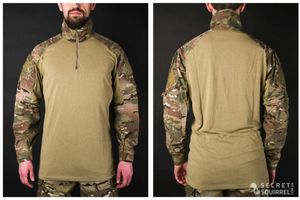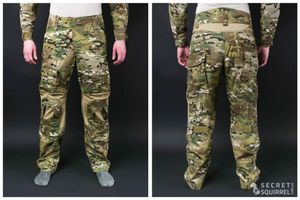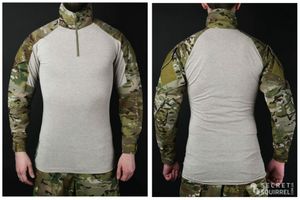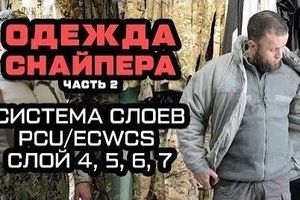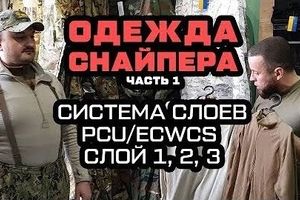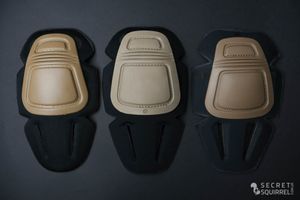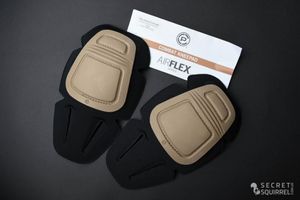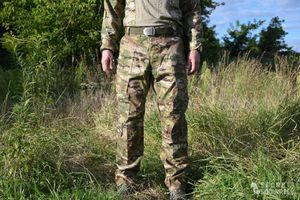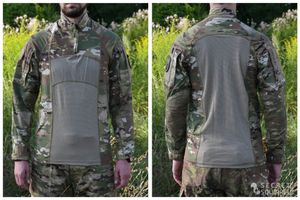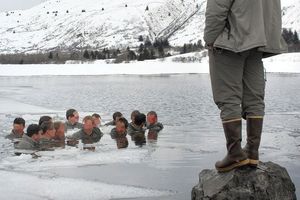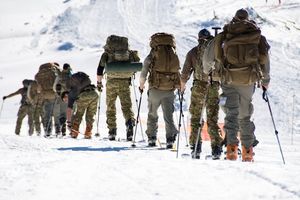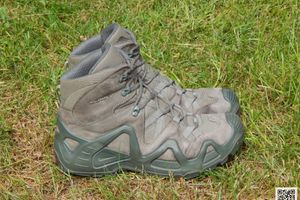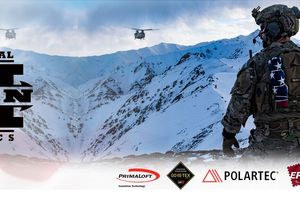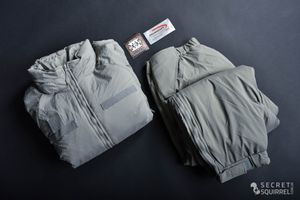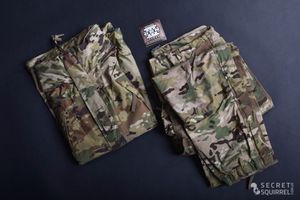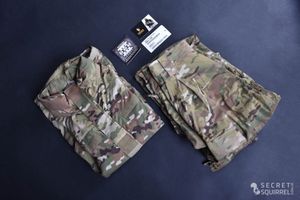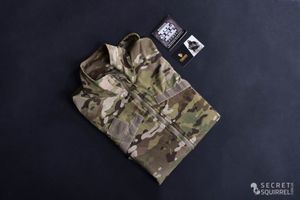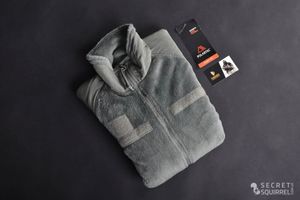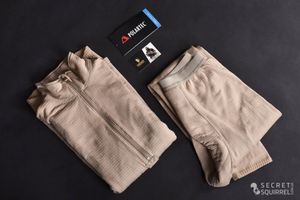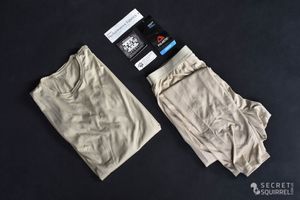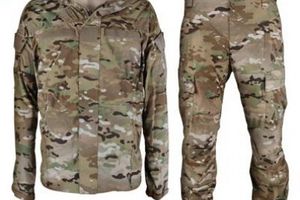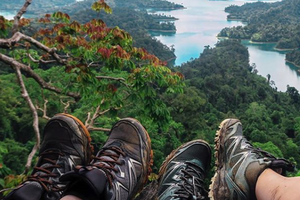
Jacket Extreme Jacket Extreme Cold / Wet Weather Jacket of the sixth level (L6) of the ECWCS system - is a rather original product, a little like other membrane waterproof jackets made of Gore-Tex material. It differs from earlier moisture-proof jackets from other ECWCS generations, it is very different from the version used by the US Marine Corps. This is a really interesting product, with competent functionality and a peculiar design, quite noticeable and standing out among its colleagues on the market, to understand which is not an easy task.


The version of the jacket in Multicam, unlike other versions, does not have any Velcro panels for fixing identification or other signs — neither national, nor full name, nor unit, nor moral. On other versions of jackets, including the version for the marines, similar panels are available. Unfortunately, it is not known for certain what caused this, however, based on the presence of such panels on other elements of a multilayer system, the obvious reason is the banal simplification of the design in order to reduce the cost.

Nevertheless, certain identification marks on the jacket are still fixed. To do this, it is equipped with a central epaulet on Velcro to fix shoulder straps with a distinction. However, at present, with the current charters, the fixation of these insignia on camouflage uniforms in the U.S. Army has been eliminated, therefore this element of the jacket’s functionality has simply remained unclaimed and unnecessary, which seems strange with the lack of panels for fixing patches.

The jacket is fastened with a central zipper - unfortunately, not waterproof, but good enough (a similar one was used on L5). However, fortunately, the zipper is covered by a double moisture and windproof strip with fixation on the Velcro textile contact fastener, which provides proper protection against rainfall.

The jacket is equipped with two vertical slots in the chest area for access to the breast pockets of the uniform, on top of which this jacket is dressed - it can be either a field uniform or a fifth layer (L5) made of soft-shell fabric or insulation layers (L3 or L7). Access to the pockets is ensured by zippers - similar to the central one, that is, also not waterproof.

Jacket sleeves are equipped with reinforcement of the elbow zone. The reinforcement material is strong enough, a similar material is also used on the Marine Corps kit; gain area is quite large. This is a big plus, since the strengthening of this zone (subject to serious wear) allows you to increase the wear time of the jacket.


Sleeves of a jacket of direct cut, with adjustment of cuffs by means of "flypaper". The cuffs themselves are quite small and quite cramped even in the case of independent wearing, they are somewhat uncomfortable to wear with thick insulating layers, so often when these are worn together, these cuffs simply do not fasten.

The jacket is equipped with a bottom hem using an elastic shock-cord and restraints. This is undoubtedly useful because it reduces the blowing of the cold wind and the windage of the jacket itself. Jacket pulling is made from the inside - for maximum neatness and the absence of protruding and interfering excess cord. The limiters are somewhat of a non-standard design, but quite convenient and comfortable.

The jacket is equipped with a large hood (it can be worn over voluminous hats or ballistic helmets, without any problems; the hood fits easily on a standard ACH of size M), equipped with a visor. The hood has an adjustment on the “Velcro” in depth, in addition, it is equipped with a pull on the oval of the face. Adjusting the hood is quite convenient, the hood does not fall on the face, does not overlap the view and allows you to adjust to any situation.


If necessary, the hood can be folded into the collar and fixed with a “Velcro” if it interferes or this is dictated by the peculiarities of weather conditions / specifics of actions. Due to the accumulation of layers of material, the solution is not convenient for every user, many simply do not fix it - this is completely optional. The folding of the hood itself into a rather neat collar is also somewhat complicated, but with experience it becomes quite simple.


The jacket is made of Gore-Tex Paclite material (tailored from a single piece, without seams, respectively, without gluing them) - it is lighter than the classic three-layer membrane hor-tex, while it has such impressive moisture and windproof properties. The jacket is well kept by wind, rain and snow, however, this material has a minus - it is more “noisy” and rustles better in comparison with the classic Gore-Tex. Although, in fairness, it should be subjectively noted that the version in Multicam is the least noisy of all used in the US Army - it is even less noisy than the version from the Morpech membrane kit. But this is subjective and 100% silent this material is not.


The jacket material is characterized by good compression properties and excellent packability - the jacket can be packaged in a fairly small volume. However, it should be noted that many (and the author of the article) continue to prefer the Morpech APECS or the second generation of membrane jackets - heavier, with worse packability, but with more tangible protection against precipitation.

This jacket is completely unlike any of its army counterparts. It is light, functional, well (although not perfect) holds the sediment. It has its advantages and disadvantages. It copes with the tasks of protection from moisture, wind and snow (in the long term, yielding to other samples), but it is somewhat specific and is unlikely to suit everyone. However, it can be recommended - this product has the right to life.
Trousers of the sixth level of the ECWCS multilayer system at first glance are distinguished by simplicity and asceticism of cut. However, this is a rather important and necessary part of this kit, which has many positive and really necessary functional properties, which are positively revealed both with an individual and with a complete wear of this uniform element.

Pants are really simple. Their design does not imply the presence of any pockets - neither patch nor mortise of various designs. They are designed to be worn over the soldier’s field uniforms (at temperatures up to +11), either the fifth layer (L5) of this system, represented by soft-shell trousers, or the seventh (L7) layer, which performs the functions of warming. Of course, these trousers can be worn individually, on top of various warming layers (L1, L2), however, their maximum functionality is revealed when they are worn together with other trousers from a field uniform or a multilayer set. It is this, as well as the desire to ensure maximum moisture protection and preservation of the contents (the absolute tightness of pockets and the protection of their contents from moisture cannot be ensured in any way) and the absence of pockets is dictated. Of course, this is somewhat depressing, especially for prolonged wear, when hip cargo pockets are quite important (it is convenient to place various necessary things for necessities in them), however, such a solution (lack of pockets) is more likely than plus.


In their back, trousers have reinforcement in the “fifth point” area - quite voluminous, covering almost the entire “loin portion” and reliably protecting this area from wear. A similar solution is used on the Marpech version of the moisture protection kit in MarPat, it is quite convenient and justified, because it increases the life of the trousers.

The trousers are adjustable in volume at the bottom with a Velcro textile contact closure. The solution itself is not new and was used on the old generations of the kit, where it proved to be quite convenient and practical, since it allows you to protect the bottom of the pants well from getting wet, blowing in the wind and also reduces the sailability of these legs. However, it was not without negative aspects - the size of the contact parts of the Velcro, in comparison with similar elements on previous generations of sets, decreased significantly, which negatively affected the reliability of fixation; and the “Velcro” itself differs in quality for the worse - it is easier to clog and wear easily. However, this is not a critical drawback - fortunately, its replacement is simple and easy to carry out in the field.
The trousers themselves are equipped with zippers to facilitate the wearing of trousers over the uniform / other layers of the kit and shoes. Lightning goes down to the knees; a moisture-proof option is used here, which for additional protection (similar to the solution on the jacket) is covered with a double wind-and-moisture-proof strap with Velcro (again, we return to the issue of the quality of this Velcro itself - it is strongly recommended to have a repair kit in stock, these elements do not inspire confidence) . This allows you to conveniently and simply wear trousers if necessary without harm to the overall protective performance.
Pants are also equipped with reinforcement in the knee area. Large enough, made of dense material, which has a positive effect on the overall strength characteristics of trousers, since this element of the functional protects areas subject to wear and tear. This is very important if you take into account the low strength of the main material of the trousers.
The trousers are fitted with Velcro slots for access to the mortise pockets of field / other trousers over which they are dressed. Sometimes this is quite useful, but most often they practically do not use this element of the functional due to the difficulty of access to the contents and the frequent discrepancy between the placement of slots and uniform pockets. In addition, you can often forget that this is just a slot, and not a full pocket, put a thing there and lose it when walking - in this regard, this element of functionality is not made very well.

Adjustment of trousers in the waist area is done using an elastic cord and two clips; there are also loops for the waist belt, which are extremely rarely used - most often, enough adjustment with the help of a shock cord. In addition, the trousers are equipped with a codpiece with a snap on the button - to facilitate dressing and removal, as well as to more easily fulfill the needs of the body.

The trousers are made of Gore-Tex Paclite material - it is lighter than the classic three-layer membrane hor-tex, and at the same time it has such impressive moisture and windproof properties. Trousers keep wind, rain and snow well, but this material has a minus - it is more “noisy” and rustles better in comparison with the classic Gore-Tex. Although, in fairness, it should be subjectively noted that the version of the pants in Multicam is the least noisy of all the membrane trousers used in the US Army - it is even less noisy than the pants from the Morpech membrane kit.

These are really simple, ascetic, primitive even, but quite functional trousers, created for the sole purpose - proper protection from precipitation. And they fulfill their goals perfectly. Lightweight, well-packaged trousers with good breathability that hold any rain, wind and snow. Yes, somewhat specific, yes, not as oak as trousers from the second generation of Equax or from the Marine set, but still having the right to life. Feel free to recommend.


























































































































